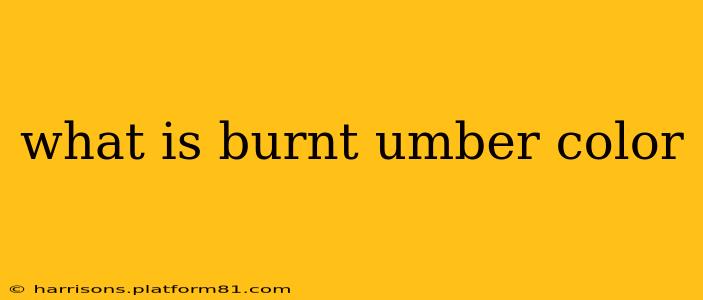Burnt umber is a rich, dark brown pigment with reddish-brown undertones. Its deep, earthy hue makes it a popular choice in painting, design, and even hair coloring. But what exactly makes this color unique, and where does it get its name? Let's delve into the fascinating world of burnt umber.
What Makes Burnt Umber Unique?
Burnt umber's distinctive character stems from its composition and the process of its creation. Unlike many other pigments, it's a naturally occurring earth pigment derived from hydrated iron oxides and manganese oxides. This gives it its warm, translucent quality and the ability to blend beautifully with other colors. The "burnt" in its name refers to the crucial step in its production: raw umber is heated, changing its color from a yellowish-brown to the deep, reddish-brown hue we know as burnt umber. This process alters its chemical composition, resulting in a pigment that's both durable and versatile.
What is Raw Umber?
Before we can fully understand burnt umber, we must first understand its precursor: raw umber. Raw umber is the unheated form of the pigment, exhibiting a yellowish-brown tone. It's also an earth pigment containing hydrated iron oxides and manganese oxides, but its coloration is lighter and less saturated than its burnt counterpart. The heat treatment is the key difference, causing a chemical transformation and leading to the darker, richer color.
How is Raw Umber Different from Burnt Umber?
The primary difference between raw and burnt umber lies in their color and tone. Raw umber is a lighter, yellowish-brown, while burnt umber is a much darker, reddish-brown. This difference affects how the pigments are used. Raw umber might be preferred for lighter washes or underpainting, while burnt umber's intensity makes it ideal for shadows, depth, and creating rich, earthy tones.
What Color is Burnt Umber?
While the name suggests a simple answer, describing burnt umber precisely is challenging. Its appearance can subtly vary depending on the specific source of the raw materials and the heating process used. However, generally, burnt umber can be described as a dark reddish-brown, or a deep brown with red undertones. Think of the color of rich soil after a rain, or the deep brown of dark chocolate with a hint of rust.
What is Burnt Umber Used For?
Burnt umber's versatility extends across numerous applications:
-
Painting: A mainstay in oil painting, watercolor, and acrylics, burnt umber serves as a base color, shadow color, and mixing agent. Its ability to blend smoothly makes it ideal for creating natural-looking landscapes and portraits.
-
Hair Coloring: The earthy tones of burnt umber translate well to hair color, providing a warm, natural-looking brown with reddish highlights.
-
Interior Design: Burnt umber is a popular color choice for walls, furniture, and accents, lending a sense of warmth and sophistication to a space.
-
Cosmetics: The pigment's natural earth tones also appear in some cosmetic products, like eyeshadows and bronzers.
Is Burnt Sienna the Same as Burnt Umber?
While both are earth pigments and share a similar dark brown hue, burnt umber and burnt sienna are distinct colors with differing compositions and tonal qualities. Burnt sienna leans more toward a reddish-brown, while burnt umber exhibits a deeper, more reddish-brown hue with possible underlying reddish-orange notes.
Where Can I Find Burnt Umber Pigment?
Burnt umber pigment is widely available from art supply stores, both online and brick-and-mortar locations. It's offered in various forms, including powdered pigment, oil paints, watercolor paints, and acrylic paints. You can also find it in pre-mixed colors in many home improvement stores for interior design purposes.
In conclusion, burnt umber is more than just a color; it's a rich, earthy pigment with a fascinating history and a wide range of applications. Its unique properties make it a valuable tool for artists, designers, and anyone seeking to incorporate the beauty of natural earth tones into their work.
